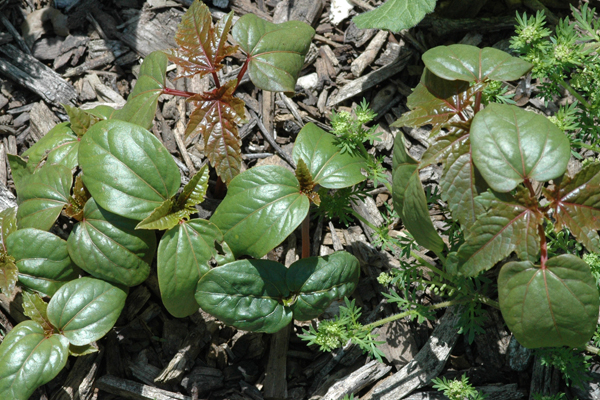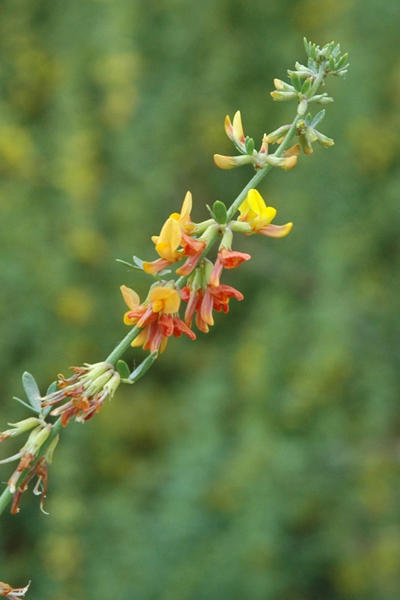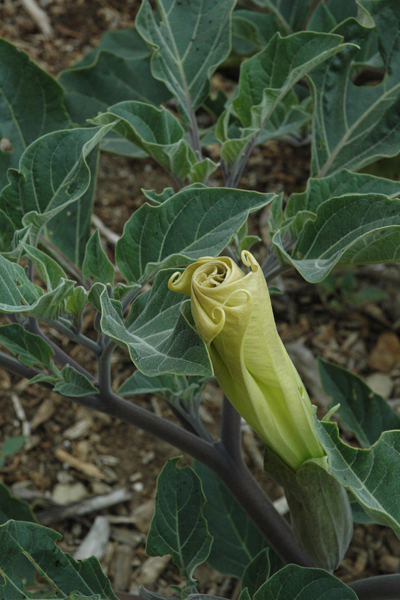

We focused mostly on the central mounds where castor bean seedlings, mustard and other exotics were planning an attack. I would like to say that the weeds are in retreat but, alas, this is a long-term project. We have made amazing progress but it took years to get this way and it will takes years to reverse it.
Park Enemy: castor bean seedlings. Pull if you see them.

Weeds, as many of you know, are just plants growing in places you do not want them to be. Here in California, and throughout much of the world, many plants from far away places have found a good home with few nature enemies and little competition. They are aggressive bullies that force out the native plants, reducing biodiversity and limiting food supplies for native animals. Some, like castor bean, grow so large that they shade out our lovely, delicate native wildflowers. Other weeds, like arundo, suck the water from the ground, forcing out all other plants, and providing poor habitat for most birds. Where these non-native, invasives grow, little else can grow.
In California, hillsides and fields of multi-colored wildflowers once teamed with life and delighted all who saw them. Now mustard colors the slopes a lovely yellow, but unfortunately at the expense of lupines, tidytips, poppies, phacelias, and untold other wonders. When I hike I see the mustard and ripgut everywhere and I wonder whether we will ever win this battle and restore balance and diversity to the land.
Since Friends of the Nature Park started weeding back in spring of 2006 I have thought hard about methods of weed control. I've read books and articles on the subject and spoken with experts. I see progress but wonder what we could do to be more successful with the limited resources we have.
Weed control by our group has only involved pulling. Weeds with no flowers or seeds are pulled and left to dry up in the sun. Weeds with flowers or seeds are bagged and removed. This has the disadvantages of being very labor intensive, difficult once the ground dries up, and it causes a great deal of soil disturbance.
I have been thinking about trying another method: weed whipping the exotics to keep them from going to seed. We would have to visit the park frequently to make sure we never let the weeds reach maturity. We would also have to be very careful to target the weeds, allowing any native seeds to germinate and grow. Timing is critical. We would go after each weed right as it emerges.
Anyone who has been working at the Nature Park knows how difficult and frustrating this work is, but they also know how much progress we have made. We are beginning to see some native that would never had made it if the weeds had been allowed to grow. There has been more miners lettuce (Claytonia perfoliata), fiddleneck (Amsinckia), and miniature lupine (Lupinus bicolor). Mugwort (Baccharis salicifolia) is sprouting here and there, and golden currant (Ribes aureum) is appearing all over. Jimson weed (Datura wrightii) is also doing very well. Coast live oaks (Quercus agrifolia) and southern California walnuts (Juglans californica) are sprouting from seed.
So when those who have not seen where we have come from, what we are up against, and how much progress we have made, comment on the condition of the park, I want them to get educated by coming on down to help out.
The state grass, purple needlegrass (Nassella pulchra) appeared on the mound near the deerweed.

A lovely stand of blue elderberry (Sambucus mexicana) with wild cucumber (Marah macrocarpus), golden currant (Ribes aureum), and jimson weed (Datura wrightii).

Blue wildflowers of globe gilia (Gilia capitata) grow with buckwheat (Eriogonum fasciculatum), sagebrush (Artemisia californica), and bush sunflower (Encelia california), all coastal sage scrub plants.

Delicate tendrils of wild cucumber (Marah macrocarpa) curl from the stems.

Deerweed (Lotus scoparius) is a native shrub found in areas of disturbance, like our Nature Park.

Jimson weed (Datura wrightii) is another early pioneer plant for areas that have experienced rapid change or disturbance.

No comments:
Post a Comment